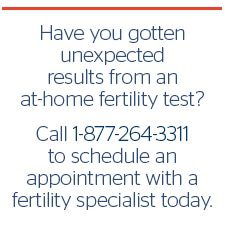Medical contribution by Naveed Khan, M.D.
Naveed Khan, M.D., is board certified in obstetrics and gynecology and reproductive endocrinology and infertility. Dr. Khan has received several awards, including the Outstanding Chief Resident Award and Best Teaching Resident Recognition Award, both from the Lyndon B. Johnson Hospital, Department of OB/GYN, University of Texas, Houston Medical Center. He sees SGF patients at the Leesburg and Dulles-Aldie, Virginia, offices.
WARNING: Before you waste money on OTC test, you can get comprehensive answers from a fertility specialist—often at no cost.
In recent years, several at-home versions of common fertility diagnostic tests have been made available over-the-counter. These tests offer patients an affordable and convenient means to check their fertility at home. While there are some instances when these tests might be valuable, consumers should understand that an at-home test is not intended to replace the accurate testing conducted by your physician. “As we see more at-home testing options on the market, we’re concerned that patients may waste valuable time relying on at-home tests that may provide inaccurate or incomplete information,” explains Naveed Khan, M.D.
To help couples understand when at-home fertility testing is valuable versus when you should see your physician, Dr. Khan has explained the three different over-the-counter testing options.
At-home fertility test for female infertility: FSH tests
What does an FSH test look for?
An at-home follicle-stimulating hormone (FSH) test aims to tell users the status of their ovarian reserve, or the number of eggs remaining in the ovaries. FSH is secreted by the pituitary gland and stimulates the resting follicles inside the ovaries to develop and mature an egg for ovulation. Similar to your physician’s office, over-the-counter tests look at FSH levels on the third day of the menstrual cycle. If there is a healthy supply of follicles, the brain will not have to work as hard to recruit them, which results in a low FSH level. If you have fewer follicles, the brain will overcompensate, excreting higher levels of FSH in an effort to recruit the follicle.
Generally, how is an at-home FSH test administered?
Most at-home FSH tests are very similar to pregnancy tests administered at home. For easy testing, use a small cup to collect urine from the first urination of the day. Then dip the testing stick into the urine sample and place on a flat surface while the test results register. Depending on the test, this can take as long as 30 to 45 minutes. See the instructions paired with your at-home test for the best results.
Timing with this test is very important: all FSH testing—whether completed at home or with a physician—is to be completed on the third day of the menstrual cycle. The first day of full flow bleeding before 3:00 p.m. is considered to be day 1.
How does an FSH at-home fertility test provide an assessment?
The test evaluates the FSH levels found in the urine, returning a result of normal or elevated. If the test results are found to be elevated, it could indicate a potential decrease in ovarian function.
Are the results accurate?
- The results provide a general range as opposed to the specific number that a physician is able to obtain from a standard blood test. This range does not take into consideration your age, which has a big impact when determining the effect a higher value will have on your ability to conceive.
- FSH levels can vary from month to month, making it possible to be given a false or unreliable result. If a woman with a high FSH level takes an at-home FSH test in a month when the FSH level is skewing low, the results may appear normal. When looking at FSH, a physician would also order tests evaluating the antral follicle count (AFC), estradiol (E2), and anti-Müllerian hormone (AMH) levels. These tests, used in conjunction with FSH, offer a true look into the status of the ovarian reserve.
- At-home FSH tests are not accurate when taken while on a hormonal contraceptive like birth control pills. It is suggested to stop any hormonal contraception for at least 60 days prior to using an at-home FSH test.
- While this test does provide some insight into potential ovarian reserve, it does not evaluate the numerous other causes of female infertility, ranging from ovulatory disorders to fallopian tube blockages.
At-home fertility test for female infertility: ovulation predictor kits

What does an ovulation predictor kit look for?
After an egg is developed and matured, a surge in luteinizing hormone (LH)—released by the pituitary gland—causes the follicle to break open, releasing the mature egg into the fallopian tube. This process is known as ovulation. Determining the exact time of ovulation, especially for women with irregular cycles, can help take the guesswork out of knowing the best time to conceive. For this reason, ovulation predictor kits (OPK) can be very helpful. For many patients, ovulation predictor kits start out as a timing tool, but if ovulation never comes, they can quickly turn it into a home diagnostic test, potentially indicating an ovulatory disorder such as polycystic ovary syndrome (PCOS).
Generally, how is an at-home ovulation predictor test administered?
This test is also similar to a pregnancy test administered at home, meaning it uses hormone levels found in urine to determine the outcome. Collect a small amount of urine, then dip the testing stick into the sample and place on a flat surface while the test results appear. Depending on the test, this usually takes only a few minutes. There are several factors that can impact your test results, so consider these when testing:
- First urine sample of the day is not necessary when taking the test, but since this test will likely be repeated for several days, it is suggested to administer the test at the same time each day.
- An excess intake of water and fluids can dilute the LH level found in the urine; try to limit the intake of fluid a few hours prior to taking the test.
For best results, see the instructions paired with your test.
Determining when to start taking ovulation predictor tests is an important part of the test. Generally, it is advised to identify the average length of your cycle to time the appropriate day to initiate testing. If your cycle is irregular, finding the right time to start can be difficult. Many OPKs would advise users to start using the test strips around day 9 of your cycle, considering day 1 to be the first day of full menstrual flow. Consult your test for a chart that can help to identify the most ideal time to start testing for ovulation.
How does the at-home fertility test provide an assessment?
The test looks for above normal levels of LH in the user’s urine. Once an elevated level is determined, the test will yield a positive reading. This suggests that the user is close to ovulation and should plan intercourse within the next 24 to 48 hours to increase the chances of conception.
Are the results accurate?
- Patients currently taking Clomid can use ovulation predictor kits, but keep in mind that Clomid can affect the length of your cycle, and as a result, you will likely need to take several more days of tests before the LH surge will occur.
- The length of time from the start of a detectable LH surge to the descent of the spike can occur within a 24 hour period, making it possible to have a LH surge between tests. It may appear that the surge prior to ovulation never occurred, when it reality it has, leading to inaccurate results and poor timing of intercourse.
- Women with PCOS can have difficulty with OPKs for many reasons. Increased androgens, or male sex hormones, can cause the time between periods to be longer than normal, or periods and ovulation to not occur at all. As a result, women that don’t realize they have PCOS could find OPKs a costly test requiring significantly more testing strips than a woman with a normal cycle. Another reason why women with PCOS may have difficulty with OPKs is because they often have consistently elevated LH levels, possibly indicating ovulation when it really is not occurring. Consistently “positive” results would indicate that OPKs might not work for you, and a conversation with your OB/GYN would be a logical next step.
At-home fertility test for male infertility: semen analysis
What does a semen analysis look for?
A surprising 40 to 50 percent of all infertility cases are caused by male factor infertility. Luckily, the evaluation for male factor infertility is one of the easiest tests to complete in the entire infertility work-up. A comprehensive semen analysis evaluates the quantity and quality of the male partner’s sperm, specifically looking at factors including sperm count, morphology (size and shape), and motility (the number moving in a forward progression). Semen analysis results that fall below the 2010 World Health Organization (WHO) standards indicate male factor infertility.
Generally, how is an at-home semen analysis test administered?
Semen testing at home starts with the collection of a semen sample, preferably via masturbation. Allowing the semen sample to sit for 20 minutes allows for the sample to thin, making administration of the test easier. At-home tests call for a small amount of semen to be drawn up into a syringe and then ejected into a “well” on the test. Several minutes later, the answers will register on the test. This test is slightly more involved than a urine based test, so for this reason, it is important to carefully read the instructions provided with your test.
While this test can be completed at any point in the month, abstaining from ejaculation for 2 to 5 days prior to the test is necessary for the best results.
How does the at-home fertility test work?
At-home semen analysis kits determine the number of sperm in the ejaculate by testing the level of SP-10— a protein compound found on the surface of the head of a sperm cell—found in the sample. . The greater the concentration of SP-10, the greater the number of sperm in the sample, with an excess of 20 million yielding a positive result. Low levels of SP-10 return a negative result, indicating a sperm count of less than 20 million.
Are the results accurate?
- At-home tests provide insight into the number or quantity of sperm count, however they do not evaluate the quality. While a sample may have over 20 million sperm—indicating a suitable count—if the sperm are not normally shaped or moving in a forward progression, they will likely be unable to fertilize an egg, resulting in male factor infertility.
- A reliable and accurate semen count is only available when performed in a laboratory by a trained andrologist that counts the individual sperm from a portion of the sample.

Is at-home fertility testing a viable option?
“There are some cases when at-home fertility testing can be insightful, but they should not be considered a replacement for the tests traditionally completed at your doctor’s office,” explains Dr. Khan. The results from fertility testing administered at home should never trump the standard America Society for Reproductive Medicine (ASRM) recommendations for when to seek a complete infertility work-up. For example, even if fertility tests completed at home do not indicate a potential problem, a complete evaluation with a physician should not be delayed. If a woman under the age of 35 hasn’t conceived after 1 year of unprotected intercourse, or 35 years and older after 6 months, she should consult with a fertility specialist. A comprehensive fertility evaluation can only be completed by a physician, usually a reproductive endocrinologist.
For couples that have been trying to conceive for less than the recommended ASRM timeframe, testing their fertility at home can be helpful for many reasons explains Dr. Khan. “For the couple that has been trying to conceive for 6 months but expected pregnancy to occur within the first 3, taking an at-home fertility test may help to put their minds at ease.” He goes on to explain, “The human reproductive system is not efficient. Women have about a 20 percent chance of conception each month, so it might take a little longer than expected.”
At-home fertility tests can also help patients if they return unexpected results, like a high FSH level, ovulation that never occurs, or a low sperm count. It is likely that without the at-home tests, the couple would have waited several months before realizing there was ever a problem. Unexpected results from an at-home fertility test warrant a conversation with their OB/GYN or fertility specialist. The reality is, these tests are not 100 percent accurate, but it’s better to be safe than sorry.
With at-home fertility testing becoming more widely available over-the-counter, we recognize that many people are going to try them. If these tests are used as per our suggested guidelines, they can help put couples at ease or alert them earlier to a problem they wouldn’t have known existed. If infertility persists and conception does not occur within the ASRM recommended time frame, it is important to schedule a full infertility evaluation with a fertility specialist.
Looking for more information on diagnosing infertility, fertility testing and how to get started?
Editor’s note: This blog was originally published in August 2015, and has been updated for accuracy and comprehensiveness as of February 2021.
To schedule a virtual consultation with an SGF physician, please call our New Patient Center at 1-888-761-1967 or submit this brief form.







